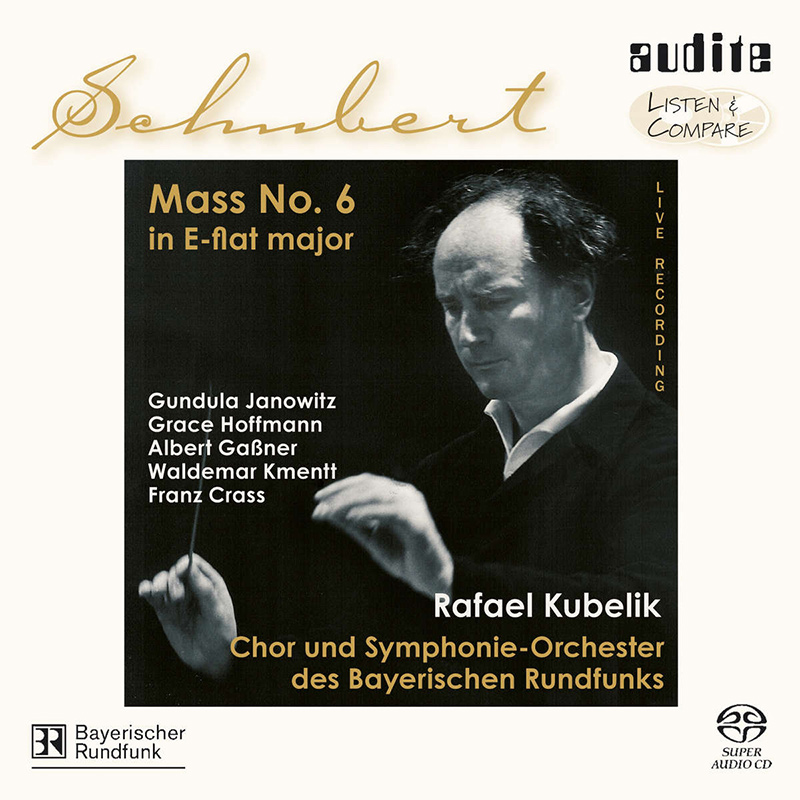Logowanie
KOLEKCJE!
BACH, CHOPIN, LISZT, MOZART, GRIEG, Dinu Lipatti, Otto Ackermann, Ernest Ansermet
The Master Pianist
PROKOFIEV, CHOPIN, TCHAIKOVSKY, SCHUMANN, BEETHOVEN, Martha Argerich, Claudio Abbado, Giuseppe Sinopoli
The Concerto Recordings
The Collection 2
Jakość LABORATORYJNA!
ORFF, Gundula Janowitz, Gerhard Stolze, Dietrich-Fischer Dieskau, Deutsche Oper Berlin, Eugen Jochum
Carmina Burana
ESOTERIC - NUMER JEDEN W ŚWIECIE AUDIOFILII I MELOMANÓW - SACD HYBR
Winylowy niezbędnik
ClearAudio
Essence MC
kumulacja zoptymalizowana: najlepsze z najważniejszych i najważniejsze z najlepszych cech przetworników Clearaudio
Direct-To-Disc
PIAZZOLLA, ChamberJam Europe
Tangos del Ángel y del Diablo
Direct-to-Disc ( D2D ) - Numbered Limited Edition
SCHUBERT, Gundula Janowitz, Waldemar Kmentt, Symphonie-Orchester des Bayerischen Rundfunk, Rafael Kubelik
Mass No. 6 in E-flat major, D 950
- Gundula Janowitz - soprano
- Waldemar Kmentt - tenor
- Symphonie-Orchester des Bayerischen Rundfunk - orchestra
- Rafael Kubelik - conductor
- SCHUBERT
Seria 'Listen & Compare'
"Anyone who doesnt have a version of this work in his or her collection could do far worse than invest in this recording." (www.musicweb.uk.net) Anton Nowakowski Gundula Janowitz Grace Hoffmann Waldemar Kmentt Albert Gaßner Franz Crass Symphonieorchester des Bayerischen Rundfunks Chor des Bayerischen Rundfunks Rafael Kubelik Schubert ’s E-flat major Mass was composed in 1828, his final year. Even though Schubert had distanced himself from his father’s bigoted piety after moving out of his parents’ house, religion was to remain a private matter of existential importance to him. He documented his own faith now and then in his works: “People were also quite surprised by my piety, which I expressed in a hymn to the Holy Virgin; it apparently takes hold of people of all dispositions, putting them in a devotional mood.” With its performance duration of approximately one hour, the Mass extends beyond the temporal boundaries of the Catholic liturgy, exceeding the given formal limits in a sovereign manner. The Kyrie, which opens the Mass with a striding rhythm in the low strings and soft trombone chords, immediately develops the large-breathed, extended, symphonic dimensions in form and expansion of the Mass attained by Schubert. The solo parts are not richly ornamented, but at times have the effect of being embedded in the overall choral texture. The operatic exposition of soloists and their virtuosity was not Schubert’s principal concern, but rather the sonic alternation between soloist and vocal ensemble in the choir of the faithful. Schubert’s overriding interest was to achieve a balance between the classical Viennese sacred music tradition, the requirements of the clergy and his own musical aims. The two extended fugues at the end of the Gloria and the Credo are doubtless among the concessions made to the sacred music tradition. Schubert seems to be searching for a new interpretation of old forms in the Mass, a different approach to that of his late symphonies. This live recording of 22 March 1968 in the Herkules-Saal of the Munich residence with Rafael Kubelik and the Bavarian Radio Symphony Orchestra is issued in SACD format. It is the continuation of our series "LISTEN & COMPARE", which offers the SACD listener the possibility of directly comparing the revised, updated version to the completely unadulterated original archive recording. Seria LISTEN & COMPMARE jest szalenie interesującym przedsięwzięciem a zarazem wielkim wyzwaniem dla nowoczesnej techniki, konfrontowanej a dokumentarnością nagrania. Oto otrzymują Państwo płytę, która na ścieżce podstawowej zawiera zreamsterowaną wersję nagrania. Na warstwie SACD - także na nowo opracowana, zremasterowana wersja nagrania, w standardzie SACD, ale także - na ścieżce SACD - pełna analogowa wersja pierwszego zapisu. Innymi słowy - materiał z taśmy- matki, surowy, bez najmniejszych ingerencji współczesnej techniki. I tu zaczyna się problem. Które nagranie jest lepsze? Którego brzmienie jest bardziej naturalne? Czy współczesna technika potrafi wzbogacić, uwypuklić, wzmocnić efekt artystyczny? Na pytania te nie da się odpowiedzieć bez posłuchania. Ale zapewniam, że po wybrzmieniu ostatnich akordów powyższe zadanie wcale nie okaże się łatwiejszym! Wielu wrażeń! (a te - gwarantuję, wystąpią wręcz w nadmiarze!)

























